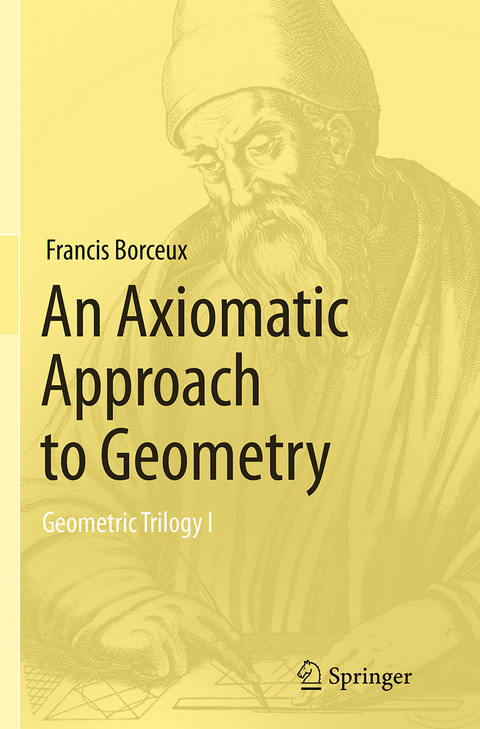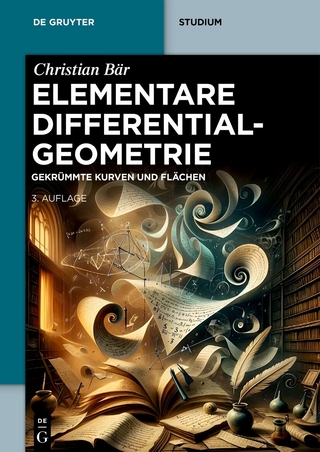
An Axiomatic Approach to Geometry
Springer International Publishing (Verlag)
978-3-319-34751-6 (ISBN)
Focusing methodologically on those historical aspects that are relevant to supporting intuition in axiomatic approaches to geometry, the book develops systematic and modern approaches to the three core aspects of axiomatic geometry: Euclidean, non-Euclidean and projective. Historically, axiomatic geometry marks the origin of formalized mathematical activity. It is in this discipline that most historically famous problems can be found, the solutions of which have led to various presently very active domains of research, especially in algebra. The recognition of the coherence of two-by-two contradictory axiomatic systems for geometry (like one single parallel, no parallel at all, several parallels) has led to the emergence of mathematical theories based on an arbitrary system of axioms, an essential feature of contemporary mathematics.
This is a fascinating book for all those who teach or study axiomatic geometry, and who are interested in the history of geometry or who want tosee a complete proof of one of the famous problems encountered, but not solved, during their studies: circle squaring, duplication of the cube, trisection of the angle, construction of regular polygons, construction of models of non-Euclidean geometries, etc. It also provides hundreds of figures that support intuition.
Through 35 centuries of the history of geometry, discover the birth and follow the evolution of those innovative ideas that allowed humankind to develop so many aspects of contemporary mathematics. Understand the various levels of rigor which successively established themselves through the centuries. Be amazed, as mathematicians of the 19th century were, when observing that both an axiom and its contradiction can be chosen as a valid basis for developing a mathematical theory. Pass through the door of this incredible world of axiomatic mathematical theories!
Francis Borceux is Professor of mathematics at the University of Louvain since many years. He has developed research in algebra and essentially taught geometry, number theory and algebra courses and he has been dean of the Faculty of Sciences of his University and chairman of the Mathematical Committee of the Belgian National Scientific Research Foundation.
Introduction.- Preface.- 1.The Prehellenic Antiquity.- 2.Some Pioneers of Greek Geometry.- 3.Euclid's Elements.- 4.Some Masters of Greek Geometry.- 5.Post-Hellenic Euclidean Geometry.- 6.Projective Geometry.- 7.Non-Euclidean Geometry.- 8.Hilbert's Axiomatics of the Plane.- Appendices: A. Constructibily.- B. The Three Classical Problems.- C. Regular Polygons.- Index.- Bibliography.
"The Geometric Trilogy is a comprehensive monograph; the readers, depending on their taste, preference, etc., may enjoy the landscape presented by Francis Borceux from the point of view of axiomatics ... . I am convinced that the readers will enjoy this book, be they either undergraduate students, teachers wishing to broaden their background knowledge, or specialists on related areas who need the concepts and techniques of geometry." (Gábor Gévay, Acta Scientiarum Mathematicarum, Vol. 83 (2), 2017)
From the book reviews:
"The axiomatic approach to geometry accounts for much of its history and controversies, and this book beautifully discusses various aspects of this. ... I thoroughly enjoyed this book, andhighly recommend it for instructors who are preparing courses in this material or who just want a great reference on their shelves. ... There are exercises and problems appearing at the end of each chapter ... . Any decent college library should own this book ... ." (Mark Hunacek, MAA Reviews, January, 2014)
"This book is eminently suitable for prospective teachers and their docents. The reader benefits from the author's long experience in lecturing geometry. The text is presented with contemporary mathematical rigor and free of strenuous historical sources ... . This wonderful book offers a deep insight into the beginning of geometric science 35 centuries before, into its further synthetic development through the ages, and into its culmination with Hilbert." (Rolf Riesinger, zbMATH, Vol. 1298, 2014)
| Erscheinungsdatum | 29.08.2016 |
|---|---|
| Zusatzinfo | XV, 403 p. 288 illus. |
| Verlagsort | Cham |
| Sprache | englisch |
| Maße | 155 x 235 mm |
| Themenwelt | Mathematik / Informatik ► Mathematik ► Geometrie / Topologie |
| Mathematik / Informatik ► Mathematik ► Geschichte der Mathematik | |
| Schlagworte | 51-01, 51-03, 01A05, 51A05, 51A15, 51A30, 51A35, 5 • 51-01, 51-03, 01A05, 51A05, 51A15, 51A30, 51A35, 51B05, 51B20 • axiomatic geometry • classical problems in geometry • Euclidean Geometry • Geometry • History of mathematical sciences • History of Mathematics • mathematics and statistics • Non-Euclidean geometry • Projective Geometry |
| ISBN-10 | 3-319-34751-9 / 3319347519 |
| ISBN-13 | 978-3-319-34751-6 / 9783319347516 |
| Zustand | Neuware |
| Haben Sie eine Frage zum Produkt? |
aus dem Bereich


